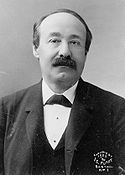Charles Joseph Bonaparte

Charles Joseph Bonaparte (* 9. Juni 1851 in Baltimore, Maryland; † 28. Juni 1921 in Bella Vista, Baltimore County, Maryland) war ein US-amerikanischer Politiker, der dem Kabinett von Präsident Theodore Roosevelt als Marineminister und als Justizminister angehörte. Bonaparte gilt als Gründer der US-amerikanischen Bundespolizei FBI.[1]
Leben
Charles J. Bonaparte war ein Enkel von Jérôme Bonaparte, dem jüngsten Bruder von Napoleon I., also der Großneffe des französischen Kaisers. Seine Eltern waren Jerome Napoleon Bonaparte (1805–1870) und Susan McWilliams (1812–1881), von denen die amerikanische Linie der Familie Bonaparte abstammt. Nachdem er an der juristischen Fakultät der Harvard University graduiert hatte, wurde er Anwalt in Baltimore und engagierte sich in städtischen und nationalen Reformbewegungen. Am 1. September 1875 heiratete er Ellen Channing (1852–1924). Die Ehe blieb kinderlos.
Zwischen 1902 und 1904 war Bonaparte Mitglied der US-Indianerbehörde, 1904 Vorsitzender der nationalen Staatsdienstreformliga und Verwalter der Katholischen Universität von Amerika. 1905 berief Präsident Roosevelt Bonaparte, der der Republikanischen Partei angehörte, als Marineminister in sein Kabinett. Von 1906 bis zum Ende der Präsidentschaft Roosevelts 1909 war er Justizminister (United States Attorney General). Er war verantwortlich für das Aufbrechen vieler Wirtschaftskartelle, beispielsweise des Tabakmonopols. 1908 gründete Bonaparte das Bureau of Investigation (BOI), das spätere FBI. Er war einer der Gründer und zeitweiliger Präsident der National Municipal League.
Siehe auch
Literatur
- Joseph Bucklin Bishop: Charles Joseph Bonaparte: His Life and Public Services. 1922.
- Eric F. Goldman: Charles J. Bonaparte: Patrician Reformer, His Earlier Career. 1943.
Weblinks
- Biografie beim Justizministerium
- Charles Joseph Bonaparte in der Datenbank Find a Grave
- Charles Joseph Bonaparte im Miller Center of Public Affairs der University of Virginia (englisch)
Einzelnachweise
- ↑ The architect of the FBI was Napoleon’s great-nephew, Charles Bonaparte. In: Washington Post. ISSN 0190-8286 (washingtonpost.com [abgerufen am 23. August 2022]).
| Personendaten | |
|---|---|
| NAME | Bonaparte, Charles Joseph |
| KURZBESCHREIBUNG | US-amerikanischer Politiker |
| GEBURTSDATUM | 9. Juni 1851 |
| GEBURTSORT | Baltimore, Maryland |
| STERBEDATUM | 28. Juni 1921 |
| STERBEORT | Baltimore County, Maryland |
Auf dieser Seite verwendete Medien
Seal of the United States Department of Justice. The coloration does not quite match the version seen on the Department's home page, but does appear elsewhere on the website.
The origins of the seal are unknown; it was first used in the 19th century as the seal for the Office of the Attorney General (prior to the formation of the Department of Justice) but the exact date is unknown. Even the translation of the Latin motto is murky, a matter of debate between Latin scholars. The Department's currently accepted translation is who prosecutes on behalf of Lady Justice, referring to the Attorney General. The current-day seal dates from 1934, when some (though not all) of the heraldic mistakes on the original were corrected. More information here.Flag of the United States Secretary of the Navy. It dates from at least 1865, and the version with four stars since at least 1867, remaining mostly unchanged since (though the anchor has gradually gotten bigger and been redesigned a bit). It is defined in naval regulations, document NTP 13(B) [1] section 1806, as:
- The flag of the Secretary of the Navy shall consist of a rectangular blue field with a fouled white anchor in the center. Four white stars flank the anchor, two on each side, all with one point of each star upward. A gold fringe is authorized for use on the flag when it is displayed in a static, indoor position. The cord and tassels are of golden yellow.



